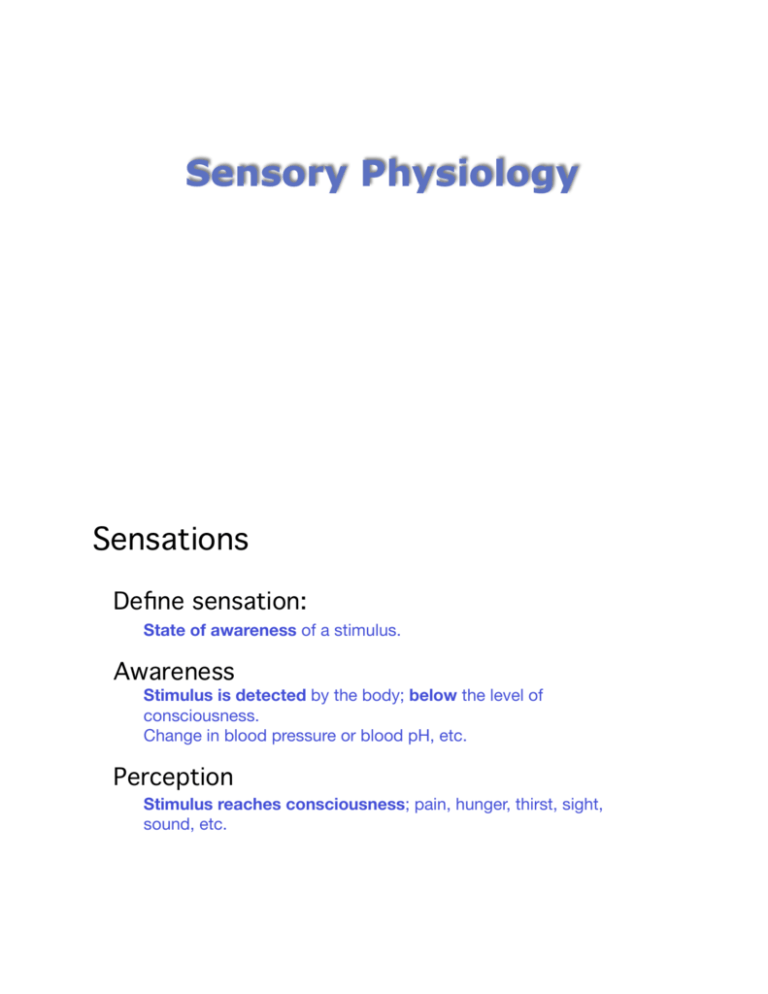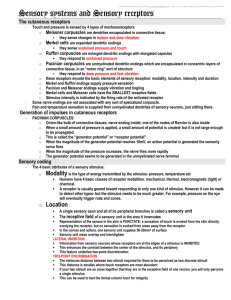general senses 2014.key
advertisement

Sensory Physiology Sensations Define sensation: State of awareness of a stimulus. Awareness Stimulus is detected by the body; below the level of consciousness. Change in blood pressure or blood pH, etc. Perception Stimulus reaches consciousness; pain, hunger, thirst, sight, sound, etc. Sensation requires 1) stimulus Any change in the environment; internal or external,; can generate a stimulus. Example: body temp, pH, BP, light, sound. 2) receptor Structure which detects a stimulus; converts it into APs. 3) impulse conducted Action potential is sent via dendrites to the CNS sensory somas. 4) translation Particular regions of the CNS will receive the APs; convert them to an awareness of the stimulus. Receptor potential Receptor potentials: Changes in the transmembrane potential of a receptor caused by the stimulus. Generator potential Generator potentials: receptor potential that is strong enough (reaches threshold) to generate an AP in a receptor. Strong stimulus causes a large change in the receptor potential, which is then more likely to cause an action potential to fire. Remember that APs are all-or-none. Stronger the stimulus (above threshold) the more APs over a given time. Characteristics of sensations 1)Projection Perception of a stimulus is mapped to the surface of the body where the stimulus is applied. 2)Adaptation Frequency of action potentials declines over time even if the stimulus is still present. Sensation declines. Phasic Rapidly adapting; pressure, smell, taste. Tonic Slowly adapting; pain. Characteristics of sensations 3) Afterimages Persistence of sensation after the stimulus is removed. After image of bright lights, for example. 4) Modality Feature by which one sensation is distinguished from an another. Sound is distinct from vision; sound vibrations in the air vs. light. Receptor Q43 Define Dendrite of a sensory neuron is modified to detect a certain sensory modality; pressure receptors in the skin, etc. single or many (millions) of neurons Single: touch, pain, pressure, etc. Many: ear, eye, balance, etc. contain dendrites All contain modified dendrites. Classification of receptors I. Location 1)externoceptors Located on the body surface or specialized to detect external stimuli. Pressure, pain, temp, touch, etc. 2)visceroceptors Within internal organs, detect internal stimuli. Pressure, pain, fullness. 3)proprioceptors Joints and muscles. Vestibular structures and the semicircular canals of the inner ear. Limb and body position and movement. Classification of receptors II. Modalities 1)mechanoceptive Detects stimuli which mechanically deform the receptor; pressure, vibration, touch, sound. 2)thermoceptive Changes in temperature; hot/cold. 3)nociceptive (pain) Damage to the structures. 4)photoreceptors Light; vision, retina of the eye. 5)chemoceptive Chemical stimuli: CO2 and O2 in the blood, glucose, smell, taste. Classification of receptors III. Complexity 1) simple receptors Usually a single modified dendrite. general sense Touch, pressure, pain, vibration, temperature. 2)complex Highly modified dendrites, organized into complex structures; ear, eye. special senses Vision, hearing, smell, taste. General sense I) Cutaneous A) tactile 1) touch a) Hair root plexus Base of hair shaft: detects movement over the body surface. b) Free nerve endings Touch and pressure. c) Merkel's disc or tactile discs Fine touch and pressure. Meissner's corpuscles d) Meissner's corpuscles Fine touch, pressure and vibration. e) Ruffini's end organs Deep touch/pressure. Meissner's corpuscles Pacinian corpuscles General sense I) Cutaneous A) tactile 2) pressure f) Pacinian corpuscles (AKA, lamellated) Deep pressure. Sensitive to highfrequency vibrations. Pacinian corpuscles Free nerve endings and Meissner’s Also detect pressure Meissner's corpuscles General sense I) Cutaneous A) tactile 3) vibration Cyclic changes in pressure over time. Meissner's and Pacinian Detect vibration. Meissner's corpuscles Pacinian corpuscles General sense I) Cutaneous B) thermoreceptive Detect changes in temperature. Tend to adapt quickly. free nerve endings? Receptor types that detect temperature, both hot and cold. General sense I) Cutaneous C) pain/nociceptors Free nerve endings that detect trauma. Tissue damage will tear open the membranes of pain receptors. Na+ rapidly flows in, depolarizing the membrane and generating action potentials. speed/duration Acute Occurs at the time of trauma, while the tissue is being damaged. Sensation lasts only as long the damage is happening Chronic Lasts as long as the damage is present. Does not adapt well. General sense I) Cutaneous C) pain/nociceptors location Either within or on the surface of the body. Somatic Surface body pain; easy to localize. Caused by some external trauma event. Visceral Within the body, associated with internal organs; hard to localize referred (visceral) pain Pain sensations on visceral organs that are mapped or referred to the surface of the body. Reason: many organs and surface sites have common embryological origins, so common innervation. CNS sometimes cannot determine where the sensations come from. General sense II) proprioceptive sense Include both simple and complex receptors kinesthetic/proprioceptive Gives you a sense of body position and limb movement. sense of position Vestibular and semicircular apparatus of the inner ear determines how your body is positioned in 3D space. General sense II) proprioceptive sense 1) muscle spindles State of muscle contraction and stretch. 2) tendon organs Amount of tension that tendons are under. 3) joint kinesthetic Degree to which the joint is flexed or extended.. 4) maculae & cristae In the vestibule and semicircular canals of the inner ear; body position, linear acceleration and rotation.





